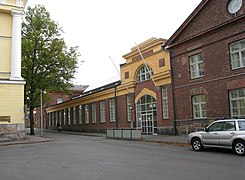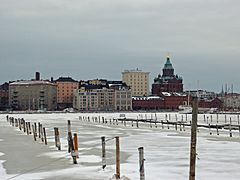Katajanokka
Katajanokka
Skatudden | |
|---|---|
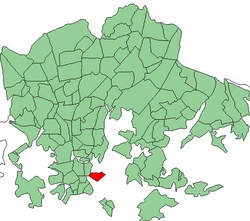 Position of Katajanokka within Helsinki | |
| Country | Finland |
| Region | Uusimaa |
| Sub-region | Greater Helsinki |
| Municipality | Helsinki |
| District | Southern |
| Subdivision regions | none |
| Area | 0.57 km2(0.22 sq mi) |
| Population (2005) | 4,167 |
| • Density | 7,244/km2(18,760/sq mi) |
| Postal codes | 00160 |
| Subdivision number | 08 |
| Neighbouring subdivisions | Kruununhaka Kaartinkaupunki |

Katajanokka(Swedish:Skatudden) is aneighbourhoodofHelsinki,Finland,with around 4000 inhabitants in 2005. The district is located adjacent to the immediate downtown area, though in the first major town plan for Helsinki from the mid-18th century, the area fell outside the fortifications planned to encircle the city.
Originally, Katajanokka was a headland of theHelsinki peninsulabut is now technically an island, as a small canal was dug across the base of the headland in the 19th century. There are four bridges across the canal connecting Katajanokka with mainland Helsinki.
Buildings in Katajanokka include the former Katajanokka prison (now aTribute Portfoliohotel by Marriott), theUspenski Cathedral,theKatajanokka Casino,Wanha Satama,theStora Ensohead office designed byAlvar Aalto,the building of theMinistry for Foreign Affairsand theKatajanokka Terminalused byViking Line.
Katajanokka is one of the most distinguished neighbourhoods in Helsinki. Katajanokka's residents have included former Finnish President (from 1982 to 1994)Mauno Koivistoand composerEinojuhani Rautavaara.
Overview[edit]
The south side of Katajanokka is dominated bya passenger harbourwhich is frequented by largecruiseferriestraveling between Helsinki,Stockholm,Mariehamn,TallinnandRostock.The rest of the district comprisesco-operativeapartment buildingsand several small parks. The western part of the residential area, known as the "Old Side" of Katajanokka, is an upscale neighborhood and a well-preserved example of early 20th centuryArt Nouveauarchitecture, though up until the mid-19th century – while the centre of Helsinki was being filled with stone buildings – the area was essentially still a wooden shanty town. The eastern part was for a long time a closed military area containing a naval base andshipyard,later a commercial shipyard. It was redeveloped in the 1970s and 1980s into a mainly residential zone, often referred to as the "New Side" of Katajanokka. The new residential area is considered an exceptional example of moderntown planning.A major part of the project was the conversion and extension of the old Russian naval barracks to house the Finnish foreign ministry.
The northern shore of Katajanokka still serves as a base for the Finnish coast guard, Helsinki maritime police as well as the Finnishicebreakerfleet.

Landmarks of Katajanokka include theRussian OrthodoxCathedral, also known asUspenski Cathedral(architectAlexey Gornostaev,1868), the Merikasarmi complex of the Foreign Ministry (architectCarl Ludvig Engel,1825) and the Finnishheadquarters ofStora Enso(architectAlvar Aalto,1962; the most controversial of Aalto's works).

Another famous building in Katajanokka is the formerdistrict prisonof Southern Finland. The old prison dates back to 1837, and functioned as a prison until 2002. The prison underwent an extensive interior renovation to convert the cells of the prison into hotel rooms, with sets of two or three cells combined to make up the current hotel rooms. TheBest Western PremierHotel Katajanokkaopened in May 2007 with 106 guest rooms. Renovations cost a reported 15 million euro.[1]As a historic building, strict limits were imposed on the redevelopment due to the strict regime of protection for historically significant buildings that is in effect in Finland. Thus, as a hotel, the exterior of the building has been preserved, as has the central corridor of the old prison and even the old prison wall. A restaurant at the lowest level of the hotel has attempted to keep much of the character of the old prison alive. However, an actual former prisoner told a Finnish newspaper that the supposed "prison cutlery" is very different from what the prison actually used: for example, prisoners never drank out of tin cups.

During the development of Katajanokka in the 1970s and 1980s, many old red brick industrial buildings were spared by converting them for public uses, such as a primary school and an indoors sports arena. There was controversy over the demolition of the former cadet school of theRussian navy,built in the early 20th century. Vacated by the Finnish military in the 1980s, the building survived, with various uses, mainly as a cultural centre. In the late 1990s, the city of Helsinki announced that it was going to demolish the building to build a new apartment building in its place. This caused huge protests, and the demolition was put off for almost a decade, mainly because of opposition from local inhabitants, and theGreen Leagueparty.
The navy school building was finally demolished in autumn 2006. However, additional problems resulted: Contrary to what the city of Helsinki and the architecture bureau responsible for the new building had thought, there was no solidrockbottom underneath the old building, but only scattered rocks here and there. Because the original building had stood there sinceCzaristRussia, no original construction plans were available, and therefore the new plans had to be redone from scratch.

The local community organisation of Katajanokka is calledKatajanokkaseura.The organization publishes an annual regional magazine,Katajanokan kaiku(Finnish for "The Echo of Katajanokka" ).
There is an annual running event called theKatajanokan ympärijuoksu,open for everyone who lives in Katajanokka or has relatives living there.
History[edit]
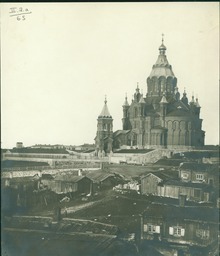

Urban settlement of Helsinki expanded from what is now theSenate Squareto Katajanokka already in the 18th century. The outskirts settlements formed on the peninsula remained mostly untouched for decades even after the rest of Helsinki had been completely rebuilt according to thezoningplan made byJohan Albrecht Ehrenströmin the early 19th century. The Katajanokka canal separating Katajanokka from the mainland and connecting the South and North Harbours of Helsinki with each other, already proposed in Ehrenström's plan, was ultimately only built in 1844.[2]
Name[edit]
The name "Katajanokka" literally means "Juniper Point" but the connection withjunipersis just a coincidence resulting from a mistranslation.
The neighbourhood was originally known in the 17th century by theSwedishnameEstnäs Skatan( "EstnäsPoint "). TheFinnish-speaking population did not understand Swedish, so the wordskata( "point" ) becamekataja( "juniper" ).
The Swedish name Skat Udden can be found from a 1775 map, while the Finnish name Katajanokka was first mentioned in theSuometarnewspaper in 1856.[3]
Barracks[edit]


From the 1810s to the 1830s barracks buildings designed byCarl Ludvig EngelandAnders Fredrik Granstedtfor the use of the Russian military were built on the eastern tip of Katajanokka. In 1831 the barracks were taken into use by theFirst marine crew of Finland,which also caused the name of the barracks to be established asMerikasarmi( "Marine barracks" ) instead of the Katajanokka barracks. This branch of the military was disestablished in the 1880s when theGrand Duchy of Finlandintroducedconscription.After this, the area became the base of the Russian Baltic fleet.[2]: 38 [4]: 308–309 After Finland became independent the garrison moved to theFinnish Defence Forces.It hosted the Helsinki navy station and military station (until 1958), the broadcast station of the radio battalion (in the 1920s) and theValmetdocks until the middle 1970s. The command of the Finnish Navy was located in a red brick building built in the 1880s until 1983 and theGuard Jaeger Regimentused the barracks in the 1960s. The deteriorated barracks buildings were renovated and restored for the use of the Ministry for Foreign Affairs from 1984 to 1989. New side buildings on either side of the old artillery courtyard were also built at the same time. A gate dating to 1776 was left as part of one of the side buildings. It is part of the artillery magazine built at the same time as theSuomenlinnafortress. Also a copy of the western officers' barracks was built on the eastern side of the barracks according to Engel's original plan.[2]: 38–39
Zoning plan[edit]
Up to the 19th century, most of the buildings on the western side of Katajanokka were old wooden buildings built in the 18th century, already badly deteriorated, and warehouses. Exceptions to this included theUspenski Cathedralbuilt in 1868, the building of theMint of Finland(1836), theHelsinki County Prisonlocated near the garrison and some apartment buildings built in the very end of the century.[2]: 28 Katajanokka had been left outside the city's zoning plan, until it became a subject of central interest in the 1870s.[5]The zoning plan in the area was confirmed in 1895. According to it, the southern shore of the peninsula was reserved for a harbour and the area north to it as a residential area. The tip of the peninsula remained in the use of the garrison.
Other building history[edit]
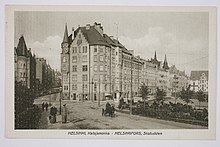
A number of brick warehouses were built in the harbour area. The neighbouring residential area, the "old side" of Katajanokka, was mostly built during one decade in the early 20th century. The buildings in the area form a rare harmoniousArt Nouveauarchitectural entity. For example the architectsGesellius, Lindgren, Saarinendesigned three of the houses: the first to be completed was theTallberg house,whose design was the trio's first competition victory.[2]: 29–35
Rebuilding of a couple of houses destroyed inWorld War IIor unbuilt lots has been done in accordance with the historical surroundings.
On the western side of Katajanokka is theStora Enso headquartersdesigned by the academicAlvar Aalto(1962), a building clad in white marble, inspired by Italian renaissance palaces. It is visible as an ending to thePohjoisesplanadistreet from theMarket Square,although a distinctive feature of the building is that it sort of lacks a frontal facade. The decorative red brickNorrmén housebuilt in 1897 had been demolished to make room for Aalto's building. There has been intense debate for several decades about whether Aalto's building fits in with the Market Square milieu and the cityscape dominated by the Uspenski Cathedral. When a white office building for the use of the development assistance department of the Ministry of Foreign Affairs was built near Aalto's building in 1993, the buildings have been seen as supporting each other and forming their own clear-bordered architectural entity.[2]: 45–46
In 1913 the so-called Chapel of Peace was built at the lot of the Uspenski Cathedral to commemorate the 100th anniversary of theTreaty of Fredrikshamn.It was seen as a symbol of Russian oppression and in 1919 nationalistic students covered it with tar. It was impossible to get the tar off the rock surface, so the building was dismantled.[4]: 303
The buildings on the eastern tip surrounding the Merikasarmi building, in the so-called "new side", consisted already in the 1920s of various buildings related to warehouse, workshop and dock activities.[2]: 38 TheKatajanokka Airportused by Aero Oy (now known asFinnair) was also located on the southern shore of the area, serving as an airport for route flights from 1924 to 1936.[2]: 9 When the navy garrison and the military harbour had moved toUpinniemiand the Valmet dock had moved toVuosaari,most of the old warehouse and industrial buildings were dismantled. The zoning plan designed by the architectural trioVilhelm Helander,Pekka PakkalaandMikael Sundmanwas confirmed in 1977 and from 1977 to 1986 a total of 21 new apartment buildings were built in the area.[2]: 36–37 The last of the free lots were built from 2006 to 2009. The zoning plan sought to return to the tightly-built urban space in a contrast to the earlier suburban type of construction, which has later been seen as a turning point in Finnish city design. The plan was also praised for taking the architectural and cultural history of the surrounding area into account.[2]: 21–24 Open spaces were sought to be measured in regard of the actual number of visitors. However, because of design norms, the building efficiency remained lower than that of the old part. The red brick facades were ordered to be laid in place, even though this was during the golden age of element construction. A large number of the houses were designed as rental orHitashouses, which caused a restriction on the cost of construction. For example parking had to be done on ground level. In the latest buildings completed in 2007 parking is handled underground.
Harbour[edit]

In the late 19th century, the southern shore of Katajanokka was built into a cargo traffic harbour, which was part of theSouth Harbour.TheHelsinki harbour rail,leading from theVR warehousessouth of theTöölönlahtibay along the city's coastline to the Katajanokka harbour, was built in 1894. The harbour was later changed into a passenger traffic harbour.
Rail transport to the South Harbour and Katajanokka ended on 30 April 1980. Traffic on the cargo harbour rail decreased as the South Harbour became mostly a harbour for car ferries. Car ferry traffic started on 9 July 1974 by the shipMSViking 5toStockholm,Sweden.[6]The site of the old harbour rail yard now hosts a wide avenue called Katajanokanlaituri, and many old warehouse buildings along it have been renovated into hotels and conference centres.
The last of the fourteen tripodal cranes on Katajanokka were built in 1959. After this, the Katajanokka harbour could at some times use two cranes for each hatch on a cargo ship.[7]One of the cranes was unloading cargo from theSSNiobewhen a chain of cargo carriages crashed into one of the crane's legs at a spot where the crane tracks and the railway tracks crossed. The crane fell down and was completely destroyed, but its driver suffered no injuries.[8]The last four harbour cranes in Katajanokka were dismantled in January 1986.
Guarding the harbour area in Katajanokka was improved on 3 May 1994 to improve passport control and customs activity. All persons present at the harbour area had to have anidentity documentwith a photograph with them. In early May 1997 the gate control of the entire South Harbour was transferred over to a security company.
The harbour activity also had side effects. From the 19th century to the middle 20th century Katajanokka was an area of ill repute, where illegal sales ofliquorand prostitution were often practised. For a long time, the image of the northern shore of Katajanokka was dominated by large warehouses belonging to afreight forwarder.These have later been renovated into the use of restaurants and cafés. The northern shore used to also host a garbage pier, where excrement was loaded into barges which took it to the countryside to act as fertiliser for the country fields. However, sometimes garbage transporters dumped their cargo right into the sea.[9]
Icebreakers[edit]

The Finnishicebreakers,with the exception of the multiple-use icebreakers, still spend their summers at the Katajanokka shore. Multiple-use icebreakers need to use the harbour only for installing and storage of equipment. This service is offered by theKotkaharbour.[10]After theValmetdock activity in Katajanokka had gradually moved to Vuosaari the old equipment pier was leased for the use of the icebreakers on 24 March 1975. The last ship launched from the dock was thetankerMTTebostaron 26 April 1974. Individual icebreakers had been spending their summers at the shores of Katajanokka also before this. For example in summer 1971 an old system was kept in force, where two icebreakers were atJätkäsaari,three atHietalahtiand three near the Valmet dock in Katajanokka.[11]The icebreakers were connected to the city'sdistrict heatingnetwork on 10 December 1979. Until this they had been generating their own heat and hot water themselves.[12]The current icebreakers areKontio,Otso,Voima,Urho,SisuandPolaris.In summertime, the icebreakers spending their summer at Katajanokka can also be rented for private events.
Plans[edit]
There was a plan to build a house for architecture and design (Armi) in Katajanokka, with a architecture design competition held in 2001. The building would have been located next to the Stora Enso main office, in place of the Kanavaterminaali building. No funding could be found for the project and the organisations behind it parted ways, so the project was finally abandoned in 2006. In 2007 there was a plan for a hotel at the same site, named after Alvar Aalto and riding on his reputation, with theSwissarchitecture bureauHerzog & de Meuroninvited to design it.
In 2006 there was a plan to build a bridge from Katajanokka toLaajasalo.The bridge would have been taken into use for trams and pedestrian traffic. In later versions the bridge was replaced with a tunnel, and a line going viaTervasaariandSompasaariwas found as an alternative route. Later, theCrown Bridgesproject was designed to pass throughHakaniemi.
There was a plan to build premises for the Helsinki emergency dispatch centre in Katajanokka.[13]However, the rent of the premises was seen as too high, and the emergency dispatch centre was moved toKerava.A new user for the caves was found, but its identity has not been made public. Explosions during the excavation of the caves caused damage in the properties along Luotsikatu.
Architecture[edit]

Katajanokka is principally known for its fine examples ofJugendstilarchitecture. Other prominent styles apparent on the island aremodernism,manifested inAlvar Aalto's Enso-Gutzeit Building, and the red-brick industrial former harbour buildings and prison (now a Best Western hotel).
Politics[edit]
Results of the2011 Finnish parliamentary electionin Katajanokka:
- National Coalition Party35.0%
- Green League20.1%
- Social Democratic Party13.0%
- Swedish People's Party8.8%
- Left Alliance8.8%
- True Finns8.0%
- Centre Party3.8%
- Christian Democrats1.2%
Gallery[edit]
-
TheUspenski Cathedralduring the turn of the 19th and 20th centuries.
-
TheMerikasarmibuilding houses theMinistry for Foreign Affairs.
-
The old machinery workshop and armoury buildings have been renovated for the use of the Katajanokka elementary school.
-
Kauppiaankatu to the west.
-
A view of the Katajanokka canal, with restaurant Sipuli in the background on the right.
-
A view from the northern shore of Katajanokka.
-
A row of red brick buildings on the "new side" of Katajanokka.
Literature[edit]

- Griffiths, Gareth (1997).The Polemical Aalto. The Enso-Gutzeit Building (1959–62),Datutop 19, Tampere.ISBN951-722-789-2(an account of the saga of Aalto's controversial building on Katajanokka.)
- Jaatinen, Carina & Lindh, Tommi & Lunkka, Hannu (1998).Helsingin kantakaupungin rakennuskulttuuri. Katajanokan kaupunginosan inventointi.Helsingin kaupunginmuseo.ISBN951-718-174-4.(An examination of the architectural history of Katajanokka.)
- Kervanto Nevanlinna, Anja (2002).Kadonneen kaupungin jäljillä. Teollisuusyhteiskunnan muutoksia Helsingin historiallisessa ytimessä.( "Tracing the lost city. Industrial transformations in the historical heart of Helsinki. With summary and captions in English." ) Suomalaisen Kirjallisuuden Seura.ISBN951-746-307-3.(Takes a critical look at the 20th Century transformation of the Eteläsatama seafront in Helsinki, with an emphasis on Katajanokka.)
- Moorhouse, Jonathan & Carapetian, Michael & Ahtola-Moorhouse, Leena (1987).Helsinki Jugendstil 1895—1915.Otava Verlag.ISBN951-1-08382-1.(Describes the architecture of Katajanokka, p. 198—228. Also available in Finnish asISBN951-1-09018-6.)
- Narinkka(1989). Helsinki City Museum. (A detailed exploration of the history of Katajanokka before the 20th Century. Written by Viljo Erkamo and Kerttuli Wessman. Includes an English summary, titled "Katajanokka's humble past. Old drawings and paintings: a documentary record of city ethnography".)ISSN0355-9106.
- Ollila, Kaija & Toppari, Kirsti (1975):Puhvelista Punatulkkuun. Helsingin vanhoja kortteleita.Sanoma Osakeyhtiö.ISBN951-9134-69-7.(Information and historical anecdotes on the city blocks and buildings of Helsinki. Covers the entire "Old Side" of Katajanokka, among other districts.)
Articles in architectural journals[edit]
- Arkkitehti1931. Frequently cited debate from the early 1930s regarding the state and the future of Katajanokka.
- Helander, Vilhelm & Pakkala, Pekka & Sundman, Mikael: Katajanokan kärjen asemakaavaluonnos. ( "The draft plan for the 'tip of Katajanokka'" ).Arkkitehti2/1975, p. 32 pp. Early description of the winning plan for the "New Side" by the architects involved.
- Pakkala, Pekka: Katajanokan vanhan asuntoalueen asemakaava ( "The plan for the old residential area of Katajanokka" ).Arkkitehti4/1981, p. 42 pp. Detailed article on the preservation of the "Old Side".
References[edit]
- ^"My City".Archived fromthe originalon 11 July 2012.
- ^abcdefghijJaatinen, Carina; Lindh, Tommi; Lunkka, Hannu:Helsingin kantakaupungin rakennuskulttuuri – Katajanokan kaupunginosan inventointi.Research and reports of the city museum of Helsinki 2/1998.ISBN951-718-174-4.
- ^Jäntti, Jarna:Helsingin Korttelieläimet: Kantakaupungin Kuvitettua Historiaa,p. 144. Espoo: Myllylahti, 2017.ISBN978-952-202-846-4.
- ^abOllila, Kaija; Toppari, Kirsti:Puhvelista Punatulkkuun, Helsingin vanhoja kortteleita,Sanoma Oy 1981 (4th edition).ISBN951-9134-69-7.
- ^Klinge, Matti:Eurooppalainen Helsinki,p. 199.Finnish Literature Society2020,ISSN2323-7392,ISBN978-951-858-185-0.
- ^Uusi Suomi9 July 1974, p. 1.
- ^Helsingin Sanomat3 June 1959, p. 7, 25.
- ^Uusi Suomi15 October 1957, p. 1, 16.
- ^Toppari, Kirsti: Vanha kauppahalli. Helsinki 1979, p. 21.
- ^Navigatorissue #5/2004, p. 9.
- ^Uusi Suomi27 April 1971, p. 14.
- ^Ilta-Sanomat10 December 1979, p. 4.
- ^"Helsingin hätäkeskuksen uudet toimitilat rakennetaan Katajanokalle".25 September 2007. Archived fromthe originalon 20 June 2008.Retrieved4 July2022.
External links[edit]
- Katajanokka home site
- Buildings of the "Old Side" of KatajanokkaArchived12 March 2018 at theWayback Machine— Pictures of all the buildings of the "Old Side", with information on the architects and dates of erection of each building
- Etymology and pronunciation ofSkatudden(in Swedish)— An article on the Swedish name of Katajanokka, published by theResearch Institute for the Languages of Finland



